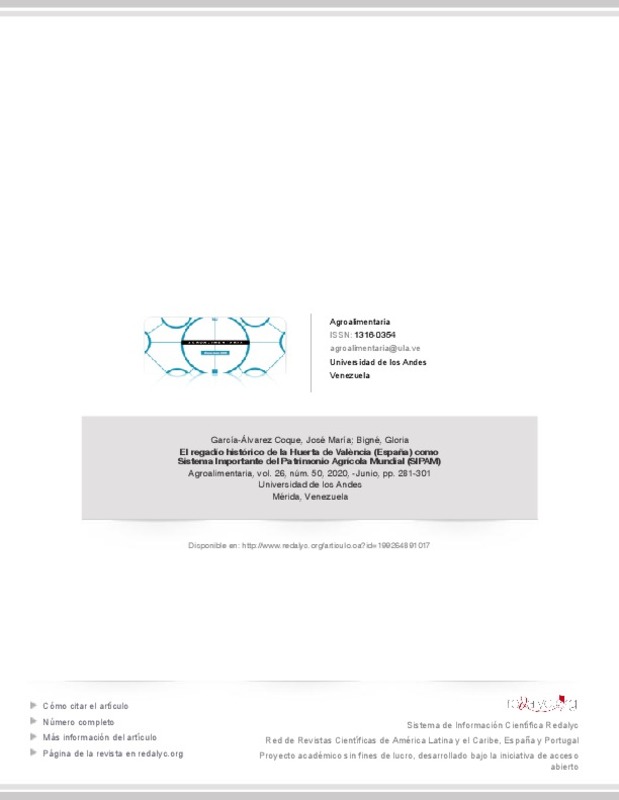|
Resumen:
|
[EN] The Globally Important Agricultural Heritage Systems (GIAHS) defined by FAO are sustainable and active
territorial systems with landscapes of great value, rich in agrobiodiversity and the result of dialogue and
mutual ...[+]
[EN] The Globally Important Agricultural Heritage Systems (GIAHS) defined by FAO are sustainable and active
territorial systems with landscapes of great value, rich in agrobiodiversity and the result of dialogue and
mutual adaptation between people and their environment. They represent dynamic sites defined not only
by geographic conditions, but also by agrarian history, tradition, and culture. The article, in the first
place, reviews the concept and characteristics of a GIAHS territory and its extension at the international
level. Secondly, it presents the results of the participatory process of formulation of a GIAHS candidature
for the case of the historical irrigation of the Huerta de Valencia (Valencian Community, Spain), with the
application of the criteria established for its recognition as GIAHS at the end of 2019 and its corresponding
action plan. It is a historical region that forms a landscape of fields watered by a system of channels of
medieval origin and encompasses a set of peri-urban agricultural areas ¿among them, Mediterranean orchards,
rice crops and artisanal fishing in Albufera. The traditional management of water for irrigation that
allows stabilizing the supply and demand of the resource is an exemplary feature for the planet, while
allowing the GIAHS de l¿Horta to adapt to the new trends of development for sustainable use. As a
resilient system, it is not exempt from the problems and challenges that affect the rest of the agri-food
systems, so this action plan must not only be compatible with the territorial planning and rural development
plans, but must also converge with territorial policies. of this peri-urban environment, as well as with the
urban food strategies outlined by the metropolitan municipalities and the involvement of the different
actors ¿universities, foundations, the agrarian community and other agents of civil society¿.
[-]
[ES] Los Sistemas Importantes del Patrimonio Agrícola Mundial (SIPAM) definidos por FAO son sistemas
territoriales sostenibles y activos con paisajes de gran valor, ricos en agrobiodiversidad y fruto del diálogo
y la ...[+]
[ES] Los Sistemas Importantes del Patrimonio Agrícola Mundial (SIPAM) definidos por FAO son sistemas
territoriales sostenibles y activos con paisajes de gran valor, ricos en agrobiodiversidad y fruto del diálogo
y la adaptación mutua entre las personas y su entorno. Representan sitios dinámicos definidos no solo por
unas condiciones geográficas, sino también por una historia, una tradición y una cultura agrarias. El
artículo, en primer lugar, revisa el concepto y características de un territorio SIPAM y su extensión a nivel
internacional. En segundo lugar expone los resultados del proceso participativo de formulación de una
candidatura SIPAM para el caso del regadío histórico de la Huerta de Valencia (l¿Horta de València, Comunidad
Valenciana, España), con la aplicación de los criterios establecidos para su reconocimiento como SIPAM a
finales del 2019 y de su correspondiente plan de acción. Se trata de una región histórica que conforma un
paisaje de campos regados por un sistema de canales de origen medieval y abarca un conjunto de zonas
agrícolas periurbanas ¿entre ellos, huertos mediterráneos, cultivos de arroz y pesca artesanal en la Albufera¿.
La gestión tradicional del agua para regadío que permite estabilizar la oferta y demanda del recurso es
ejemplar para el planeta, al tiempo que permite al SIPAM de l¿Horta adaptarse a las nuevas corrientes de
desarrollo para un uso sostenible. En tanto sistema resiliente tampoco está exento de los problemas y
desafíos que afectan al resto de los sistemas agroalimentarios, por lo que dicho plan de acción no solo
deberá ser compatible con los planes de ordenación territorial y de desarrollo rural, sino que además ha de
converger con las políticas territoriales de este entorno periurbano, así como con las estrategias alimentarias
urbanas delineadas por los ayuntamientos metropolitanos y la implicación de los distintos actores ¿
universidades, fundaciones, comunidad agraria y otros agentes de la sociedad civil¿.
[-]
|







